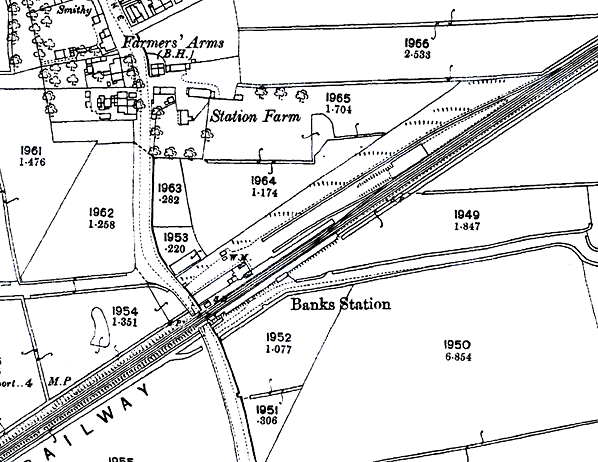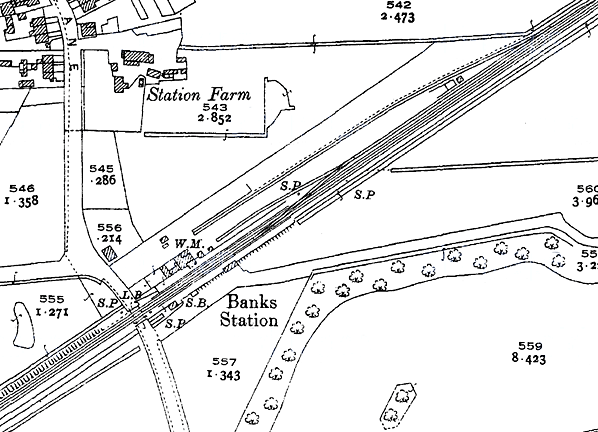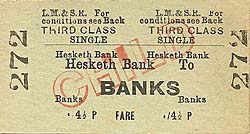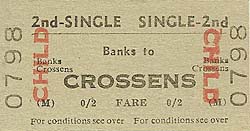
Station Name: BANKS [Source:Tony Graham &
Paul Wright]
old1.jpg) Banks station in 1963, looking north-east from Guinea Lane level crossing. The main station facilities were on the down (Preston-bound) platform.
photo from John Mann collection   1894 1:2,500 OS map. Banks station as it was in 1894. At this time the signal box was located on the Preston platform.
 1928 1:2,500 OS map. The area around Banks had not really changed much between 1894 and 1928; it was still predominantly rural. The original signal box had been replaced with the new structure on the Southport platform.
old4.jpg) A Southport Chapel Street train arrives at Banks station's down platform (looking north-east) in August 1964. 42061 was built for BR to a Fairburn design at Derby works. A development of the Stanier 4P tanks, this 2-6-4t was delivered new to 5D, Stoke Shed on 8.12.1950. It was allocated to another ten sheds during it’s working life until finally being allocated to 27C, Southport in December 1962, from where it was withdrawn on 25.9.1965 and cut up by Wards of Kilmarsh
later that year Photo by D. Hampson old5.jpg) Looking north-east towards Prestonin August 1964, less than two weeks before the line closed. The train is the 17:59 from Preston headed by LMS Fowler 2-6-4T No. 42369. This loco was delivered new on 11.9.1929 after being built at the LMS works in Derby. A Fowler designed 4P, 2-6-4-tank, it had a working life of over 35 years when it was withdrawn from Wigan, Springs Branch on 15.5.1965 and cut up in Wigan at the Central Wagon Co. by the end of that month.
Photo by Ben Brooksbank old7.jpg) A rear view of the down platform at Banks from the footplate of Lostock Hall's BR Standard 2MT 2-6-0 No. 78041; the locomotive is awaiting departure with the 14:10 Southport – Preston on 6 September 1964. Notice the row of original gas lamps still providing sterling service over half a century after being installed. Evidence of the despair, apathy and resultant lack of care that overcame many of the doomed stations on this line is visible in the uncontrolled vegetation on the fence which threatens to engulf not only the formerly well-tended flower beds but also one of the platform seats.
Photo by Alan Castle old2.jpg) A Preston service arrives at Banks station in September 1964 only days before the
station is to close completely. photo from John Mann collection
old3.jpg)
Looking north-east along the up (Southport-bound) platform at Banks station in September 1964. A Preston to Southport Chapel Street service had just arrived. 42645 is a Stanier class 4p tank built at Derby for the LMS in December 1938. It was withdrawn from 27C, Southport shed, on 11.9.1965 and scrapped at Cashmores of Great Bridge in November of that year. Note the lamp on the smokebox to identify a class B stopping train. The lamp was normally situated on top of the smokebox in front of the chimney, but was moved with the introduction of overhead wires to save the crews from getting a 25KV zap from above!
photo from John Mann collection
2.jpg) The derelict Banks station in 1968. To the right of the picture is the sloping bank of the drainage ditch that had obliterated the station's up (Southport-bound) platform.
Photo by Tony Graham 1.jpg) Looking north-east along the down platform at Banks station in August 1984. The cars are standing on the site of the station building. A drainage ditch, seen to the right, had obliterated
the former up platform. Photo by John Mann 3.jpg) Looking north-east at the site of Banks station from the site of the Guinea Hall Lane level
crossing in July 2011. Photo by Paul Wright 8.jpg) The surviving down platform at Banks station looking north-east in July 2011.
Photo by Paul Wright 10.jpg) Banks station looking south-west in July 2011. The surviving down platform can be seen to the right. The up platform was lost just after closure of the station when a drainage ditch was dug, which can be seen to the left of the picture.
Photo by Paul Wright  Home
Page Home
Page
|
1.jpg)

3.jpg)

.gif)

old_thumb6.jpg)
thumb4.jpg)
thumb6.jpg)
thumb7.jpg)
thumb8.jpg)
thumb9.jpg)